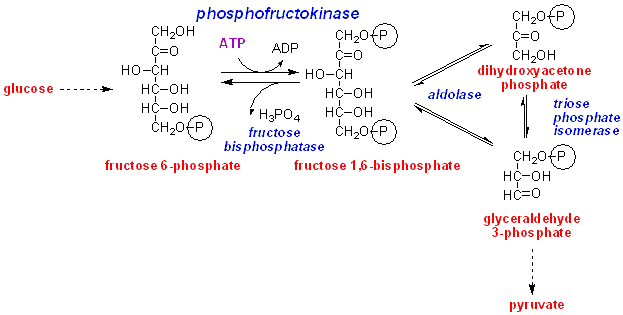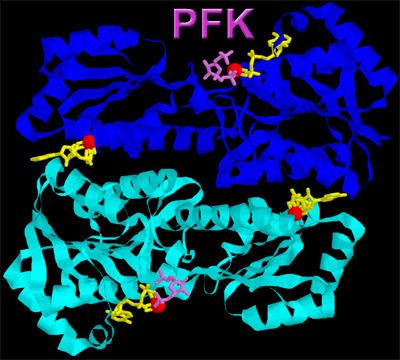Symbol Ppfruckinase InterPro IPR000023 Pfam structures | Pfam PF00365 PROSITE PDOC00336 | |
 | ||
Phosphofructokinase reaction
Phosphofructokinase is a kinase enzyme that phosphorylates fructose 6-phosphate in glycolysis.
Contents
The enzyme-catalysed transfer of a phosphoryl group from ATP is an important reaction in a wide variety of biological processes. One enzyme that utilizes this reaction is phosphofructokinase (PFK), which catalyses the phosphorylation of fructose-6-phosphate to fructose-1,6- bisphosphate, a key regulatory step in the glycolytic pathway. It is allosterically inhibited by ATP and allosterically activated by AMP, thus indicating the cell's energetic needs when it undergoes the glycolytic pathway. PFK exists as a homotetramer in bacteria and mammals (where each monomer possesses 2 similar domains) and as an octomer in yeast (where there are 4 alpha- (PFK1) and 4 beta-chains (PFK2), the latter, like the mammalian monomers, possessing 2 similar domains). This protein may use the morpheein model of allosteric regulation.

PFK is about 300 amino acids in length, and structural studies of the bacterial enzyme have shown it comprises two similar (alpha/beta) lobes: one involved in ATP binding and the other housing both the substrate-binding site and the allosteric site (a regulatory binding site distinct from the active site, but that affects enzyme activity). The identical tetramer subunits adopt 2 different conformations: in a 'closed' state, the bound magnesium ion bridges the phosphoryl groups of the enzyme products (ADP and fructose-1,6- bisphosphate); and in an 'open' state, the magnesium ion binds only the ADP, as the 2 products are now further apart. These conformations are thought to be successive stages of a reaction pathway that requires subunit closure to bring the 2 molecules sufficiently close to react.

Deficiency in PFK leads to glycogenosis type VII (Tarui's disease), an autosomal recessive disorder characterised by severe nausea, vomiting, muscle cramps and myoglobinuria in response to bursts of intense or vigorous exercise. Sufferers are usually able to lead a reasonably ordinary life by learning to adjust activity levels.
The reverse reaction is catalyzed by the enzyme Fructose-1,6-bisphosphatase.
Regulation
There are two types of the enzyme:

